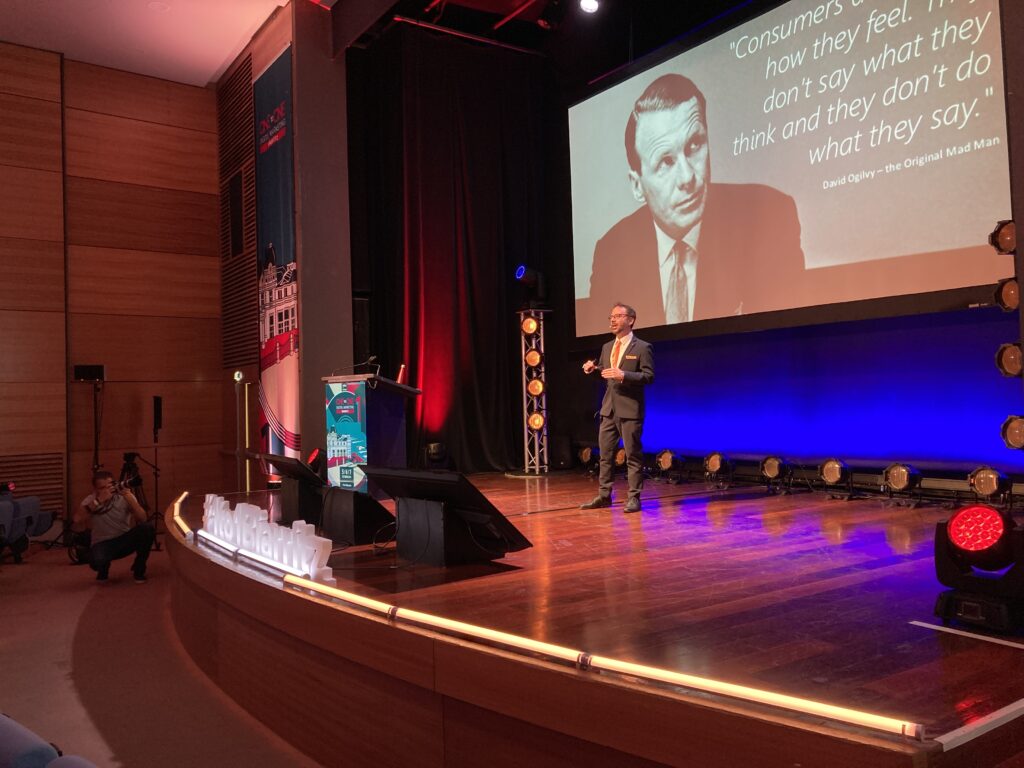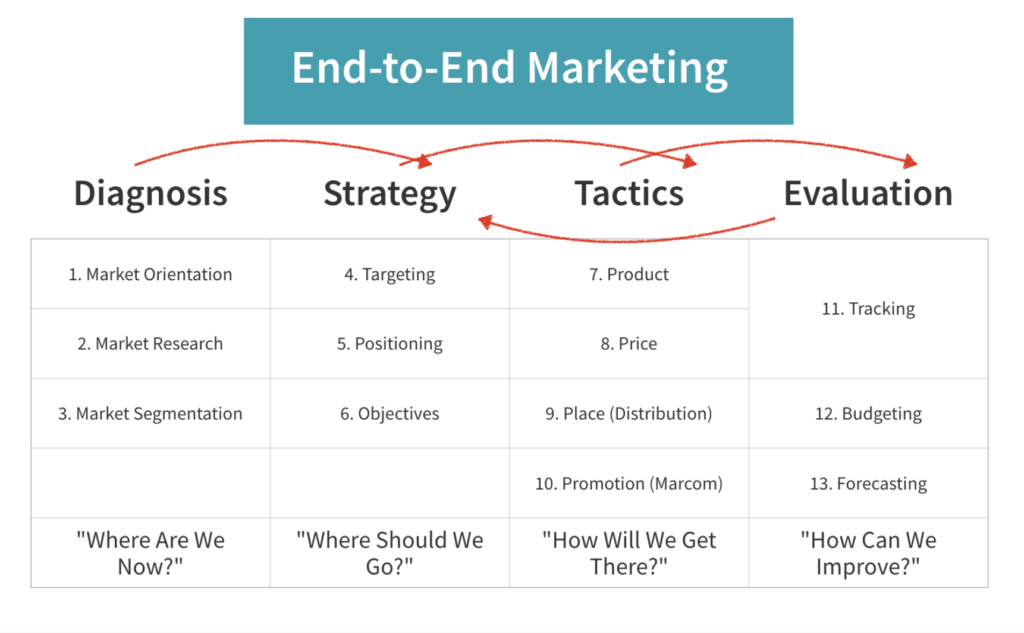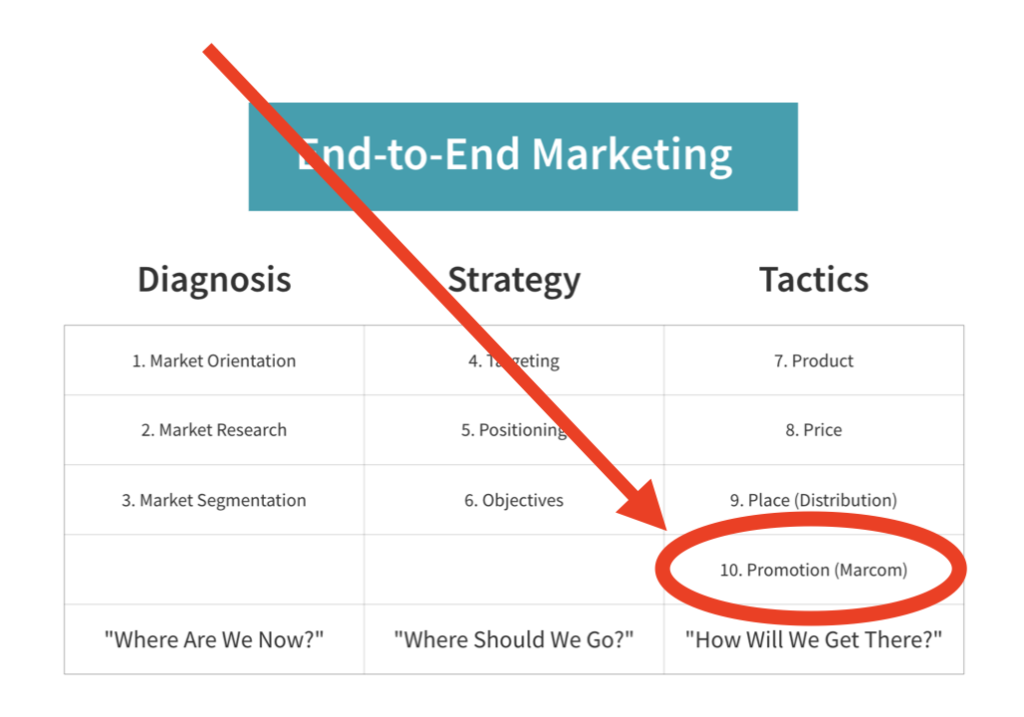
MARKETING IS NOT WHAT YOU THINK: What VCs, CEOs, and Even CMOs in the High-Tech Startup Industry Need to Know
(This speech can be adapted to any sector or industry.)
Advertising, communications, and marketing are not the same thing. In fact, they mean very different and important things. In this keynote address, Samuel outlines the entire marketing process of research, segmentation, targeting, positioning, objective setting, product creation, pricing, distribution, and promotion. The first two steps are diagnosis — understanding where you are. The next three steps are strategy — deciding where you will go. The next four steps are tactics — planning how you will get there. The last three steps are evaluation — tracking progress, forecasting, and setting budgets for the next period. To maximize your company’s value, you need to know what to do at each step. Marketing is a lot more than just “creating content.”
Actionable takeaways:
— Learn the entire, end-to-end marketing process.
— Understand how to do market diagnosis, marketing strategy, marketing tactics, and evaluation.
— See the best practices for each individual step along the way.
What Marketing Really is:
Too Many Think Marketing is Only This:
An Excerpt from an Example Talk
Example Deck
See this Slideshare from a client talk: https://www.slideshare.net/samuelscott/creating-value-for-eurojackpot-your-customers-and-the-world
Example Text (excerpt)
First, I’m going to talk about the big picture of marketing before I go into what your marketing teams can possibly do.
Most of the time, people think “marketing” is just promotional communications. Like advertising. Or publicity. Or SEO. Or influencers. But that is just communications — or marketing communications or just marcom.
But there is so much more to marketing that you never hear discussed if you listen only to wannabe marketing influencers. And there is a lot more that you need to keep in mind if you want to, say, sell more lottery tickets to millennials. I don’t know the experience levels of everyone here, so I will summarize to make sure we are all on the same page. Research, segmentation, targeting, positioning, product, price, place, and promotion.
At the top, the first half of the process is the part that is the core of marketing because you are actually studying the market. This first half is marketing strategy. Here at the bottom are the marketing tactics. Again, promotional communication comes at the very end. But that is all people often talk about.
Now, let’s briefly go through marketing strategy: Segmentation, targeting, and positioning, or STP. After you do your research into the total market, you need to create a map of that total market. And that is segmentation. Here’s how a grocery store in California segmented the total market. Different types of people live in different areas. The key to understand: If you don’t have an accurate map at the beginning of the marketing process, you won’t know how to choose where to go or who to target.
After you have a segmentation map, then you choose which segment or segments to target based on numbers, attributes, potential revenue, and so on. After you have the map, targeting is using the map to decide where to go. After you know where you’re going and which segments you will target, then you need to decide how to position yourselves to that target segment compared to the competition. Basically, what do you want them to think about you?
Once you have created a strategy by mapping and segmenting the total market, deciding who to target, choosing how to position yourselves to that target, and setting your goals, then comes the tactics. The 4 Ps Marketing Mix of product, price, place, and promotion. This is what you will do to achieve those goals. Product. What will you build for that target market? Price. What will you charge that target market? Place. How will you get your product to that target market?
And then, and only then, how will you communicate to that target market? That involves which elements of the tactical Promotion Mix to use — brand advertising, direct response, public relations, sales promotions, and personal sales. And then you must choose over which channels to do those tactics. And then you do the campaigns, measure the results, and adjust for the future accordingly.
So, in line with this framework, what can you do? Currently, your basic positioning is [private], [private], and [private] compared to the competition. For the sake of argument, I will show an example of the process based on a biased assumption from the start. I am working backwards from a hypothetical scenario where targeting millennials with brand purpose makes sense
But in reality, you can’t start with brand purpose or anything else, you have to go through the strategic process and then see what makes sense from there. For your first assignment after this talk, make a full list of all hypothetical and potential segments with whom [client] interacts. Who are all of your stakeholders? Remember: Employees were a group of stakeholders that Warby Parker did not realize would be affected by their brand purpose communications.
The whole process I will describe here can be done for any general segment. Here, of course, I’m going to target the segment of ticket buyers. Now, our hypothetical goal here is to explore how to use brand purpose to get millennials to buy more lottery tickets. So, your next assignment is to take the segment of millennials and segment them further as needed. In each of your countries, you can segment that age group further by other demographics (who they are), psychographics (what they believe), and/or behavior (what they do). Then, decide which segments to target.
Now, first of all, I always cite my sources due to my first career as a journalist before I went into marketing. Some of the principles I will now discuss come from people like Mark Ritson. If you want a lot more detail and to further your own marketing careers, I encourage you to take his MiniMBA courses in marketing and brand management. Note: I don’t get a cut of any tuition, I just like referring people to good resources.
Ritson specifically discusses a three-step-method of brand management that was first created by Neil McElroy, who was a brand manager at Proctor and Gamble in the US a century ago. It comes down to diagnosis, strategy, and tactics. You could say it is determining where you are now, where you want to go, and how you are going to get there.
One thing that [client] should do, if you haven’t already, is to create a purchase funnel that is specific to your ticket buyers. This is a simple example, but when it comes your millennial target segments, what percentage are aware of you? What percentage of those intend to buy a ticket someday? What percentage of those bought a ticket one time? And what percentage of them buy a ticket every time? You look at the conversion rates at each step to see where the conversion rate is lowest and therefore where the problems lie.
When it comes to your specific, targeted segments of millennials in your countries, another thing you should do is conduct or commission research into why they are buying or not buying tickets, what mental associations they have of you, and what they think of company brand purpose. Obviously, I do not work for [client], and it’s not my purpose here to give a definite answer. My purpose here is to provide a framework to get you thinking about the issue and suggest some hypothetical thoughts as examples.
Now, after you’ve done the research, the segmentation, and the targeting, then it is time to do the positioning. So, here’s your next assignment: Create a perception map showing you and the competition on a grid. Here’s one way to do that. First, ask yourselves who is your true competition. It might be other lotteries, or it might be substitute products, or it might be both. Here is an example of a substitute product: If someone has two euros and must choose to spend it on a lottery ticket or on something else, what is most commonly that “something else?”
The goal is to determine how the market perceives those things — it is NOT where YOU think you are. First, use your research to determine the two greatest determinant attributes — the two greatest factors that lead customers to make a choice between competitors. If you are soda, it might be the amounts of caffeine on one axis and sugar on the other. For our purposes, a commitment to brand purpose might be one of the two variables, or not. Then, survey a good sample of your segment and get each responder to rank you and each competitor on a scale of 1-5 or 1-10 for each of those two things. And then, calculate the averages for everyone and plot the results. This can help you to “see” where a hole might exist in the market and how you can position yourselves to fill that hole.
Next, come the three Cs of customer, company, and competition. The first is knowing what the customer wants. The second and third are knowing what you CAN do that will also differentiate you from the competition. Basically, you don’t want to promise something that you cannot deliver. If a person is 1.5 meters tall, and he wants to position himself as a great future basketball player, it might not work.
Last comes the benefit ladder. It’s deciding on what you will focus. Your product? The product’s features? The product’s benefits? The customer benefits? Or the emotional benefits? For [client], these five are the lottery as a whole, being able to play via an app or on something else, getting money when you win, using that money to buy stuff, and feeling happy after buying that stuff.Currently, your advertising seems to focus on the customer benefits of buying luxury products. In this hypothetical example, I will argue that you might focus on the higher, emotional benefits. Stay tuned.
When you do the positioning, you take all this information and your insights, and you write it down. The segment, the insights into the segment, what you are positioning, against which competitor, and what are the three features or benefits that you will communicate? Keep it to three at most. Because the more messages that you communicate in an advertisement, the more that each individual message is diluted, less powerful, and less memorable.
Here’s a hypothetical positioning for you based on our assumptions. For millennials, who have less money and hate luxury and believe in brand purpose, [client] should position itself against the competition by being a cool, affordable luxury that enables unforgettable experiences and helps the world. Remember: One question to ask: Who is your competition, really?
Now, here is the hypothetical journey so far. We have segmented the market into millennials or subgroups of millennials. We have decided which ones to target. We did research into what they want and what associations they have with [client]. Then, we decided how we will position [client] to those targets. That is the strategy. Now, it’s the tactics — what the marketing world usually only focuses on.
Again, much of this is hypothetical examples to make you think. As far as the product itself — how can you make it match your new positioning? It could be anything from the design of the ticket to how you purchase it.
The price also reflects on the brand. A higher price communicates higher quality and more prestige. Now, where you sell your product also reflects on the brand. And that takes us to the third P — place, or distribution. One example: If a brand of wine or liquor is sold only in first class and not in economy classes on airplanes, then that builds a certain association in everyone’s head. So instead of sticking to the same old places such as gas stations, convenience stores, and sidewalk kiosks — maybe explore the possibility of selling tickets wherever it is trendy for millennials to hang out. Maybe give those places a cut of the revenues and winnings.
And finally, we come to the tactical topic that marketers love to talk about — promotional communications. But remember: Marcom can only be effective if everything else that comes before was also effective. Now, let’s go into some of the latest theories.
Some of the findings compare the results of brand advertising and direct response. Brand advertising is the line in brown and is what delivers the greatest long-term growth. Direct response (or sales activation) is the line in yellow and is what delivers the greatest short-term growth. For the greatest growth overall, Binet and Field advocate for roughly a 60-40 split between media spend on brand and activation.For you, activation is getting people to buy tickets. Brand advertising — which tells people how to perceive your entire brand — is what I will discuss here.
Now, we know from our hypothetical research that millennials do not like expensive stuff and prefer experiences. So, my question for you is, why is [client] showing people using their winnings to buy expensive stuff instead of showing them using their winnings to have experiences?
And secondly, why not advertise how lottery programs are helping your relevant countries? In America, for example, lottery revenues fund many schools at the state level. If [client] revenues in Slovenia, for example, help education in Slovenia, then perhaps advertisements in Slovenia should say that. Of course, this would take a lot of research and cooperation from your country-specific teams and the national governments. The basic idea: Play [client] not only to get rich but also to help the world.

